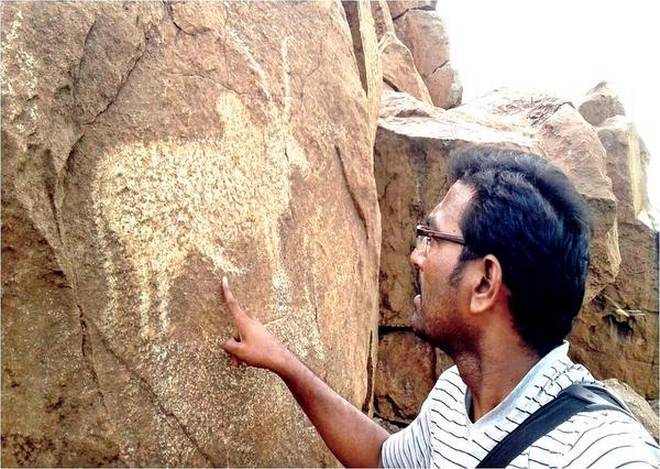
It dates back to Mesolithic, Neolithic, and pre-historic periods, says researcher of Yogi Vemana University
Kandanathi, a tiny village located about 5-km south of Yemmiganur mandal headquarters in the district, is the biggest petroglyph site in Andhra Pradesh, an exploration by an archaeology researcher of Yogi Vemana University has revealed.
The petroglyphs had attracted the attention of scholars in 2015-16. But no extensive study was made until Yadava Raghu, an academic consultant in the History and Archaeology Department of Kadapa-based Yogi Vemana University, surveyed them.
Dr. Raghu discovered rock art with engravings, and peckings and bruisings, predominantly of humped bulls and also of human figures, at Kandanathi dating back to the Mesolithic, Neolithic, and pre-historic periods.
“Kandanathi has the first biggest explored petroglyph site in the State with the detection of nearly 200 engravings, peckings and bruisings,” Dr. Raghu told The Hindu.
“Maximum depictions are outlined. A few are flat wash, and the depicted figures are that of a tiger, streak of tigers, leopards, camels, bulls, elephants and horses, scenes of riders on bulls, camels and horses, hunting scenes with bow and arrow, sword and dagger etc.,” he explained.
Carnival scene
There was a carnival scene with humans playing musical instruments such as ‘dolu’ and ‘kommu’, he said.
There were several depictions of bulls with various sizes of horns and humps, and in association with riders.
“An uncanny one is that of a robust bull in flat wash measuring 50 cm in height and 50 cm in length with a high hump and an erected organ, which dates back to the Neolithic and pre-historic periods,” Dr. Raghu said.
In addition, there were plenty of figures of animals and humans drawn on boulders such as goats, monkeys, dogs etc.
“Kandanathi is located at the foot of a hillock, locally called Nalla Kondalu, having hummocky masses varying from large blocks to boulders on which petroglyphs were depicted, and most of them are facing east,” he explained.
“The peak of the hillock has remains of a mutilated “buruju,” possibly dating to the Vijayanagara period (1336-1670 AD),” he said.
One grinding hole was noticed on the foothill located at a distance of 10 metres from the site towards the west. The rock art in the village comprised paintings/pictographs and petroglyphs.
Dr. Raghu asserted that the earliest discovery of petroglyphs (bruising) was on the Kupgallu Hill in Bellary district of Karnataka by Fawcett in the year 1892. Later, Bruce Foote had discovered some more bruisings and engravings at the Kupgallu Hill site, he said.
“An evidence of the activities of early humans and their cultural continuity are copious in the Rayalaseema region,” he said.
“Kurnool district is one of the richest zones of the prehistoric centres in the world for early human activities, and throws valuable insight into the past culture and cultural continuity to the archaeologists,” he added.
Kandanathi is surrounded by brooks namely Banavasi Vanka, Eerlaiah Sami Vanka, Giddaiah Vanka. and Yenkanna Vaagu, which ultimately join the Handri, a tributary of the Tungabhadra.
“The petroglyphs at Kandanathi reveal the presence of the Boya community divided into many exogamous groups such as Mandla (herdsmen) and Yenubothula (buffalomen).” he observed.
source: http://www.thehindu.com / The Hindu / Home> News> States> Andhra Pradesh / by M.V. Subramanyam / Kurnool – June 18th, 2018